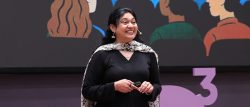In talk titled ‘Blurring Boundaries: From Computer Graphics to Human Pulse Reading’, the multi-talented Muqeem Khan takes the audience on a tour de force of his life
HABIB UNIVERSITY March 1, 2016: Mr. Muqeem Khan delivered a captivating talk on his life and creative and intellectual evolution in the nearly packed Tariq Rafi Lecture Hall here at Habib University.
Mr. Khan, who is Associate Professor of Communication Studies and Design at Habib University, holds a B.S. in Interior Design and an M.A. in Industrial Design from Ohio State University. He has several motion picture credits with Walt Disney and Square USA, including Deep Rising, George of the Jungle, Flubber, Armageddon and Final Fantasy.
In February 2016, he was selected to be part of a jury for India’s Best Design Studio Awards (IBDSA) 2016, making him the only Pakistani on the panel. India’s Best Design Studio is a respected recognition for Design Studios for their professional work, business practices and transparency, initiated by POOL Magazine in 2015 and endorsed by the India Design Council.
During his talk here, titled ‘Blurring Boundaries: From Computer Graphics to Human Pulse Reading’, Mr. Khan narrated the course of his creative and professional life, recounting how curiosity took him on the path to computer generated imagery and then to trans-disciplinary design. He shared his extensive experiences in creating motion picture realism, and shared clips and snippets from finished movies while describing the processes that went into creating them.
Having lived and witnessed the evolution of animation and computer generated imagery in Hollywood, Mr. Khan described the various challenges animators used to face and how they would work around them. He recounted how working in the industry made him appreciate and internalize that a good designer has to work within set boundaries, within which he or she has to best express their creativity given limitations of time, space and money. From his experience he believes that although talent and technology are essential for success in the field of computer graphics and animation, they are not sufficient. The extra essential ingredients are tolerance and teamwork.
Moving on to his current Ph.D. research, Mr. Khan explained how he is combining design thinking and emerging interactive technologies to help people stay in touch with their intangible cultural heritage – intangible in that it is distinguished from ‘tangible’ heritage like books, statues, museums etc. More specifically, he is investigating, documenting and transmitting the Unani medicinal practices in Pakistan.
He explained that his research focuses on perpetuating ‘Digital Intangible Heritage’ through ‘empathic design’ and associated techniques. His focus is on ensuring the continuity of cultural knowledge by using new models to access traditional knowledge.
For a better idea of Mr. Khan’s work, you can see his mixed reality experimentations and presentation, “Playful Technology to Keep Cultural Heritage Alive,” at the TED@Doha Summit.
Rounding off his talk, he played stereoscopic 2D animations generated by Habib University students for the audience. These were greatly appreciated by audience members in post event discussions.




